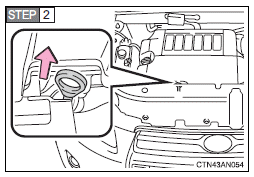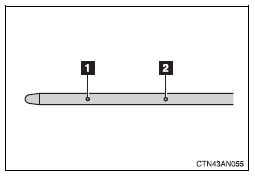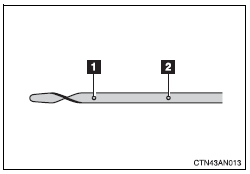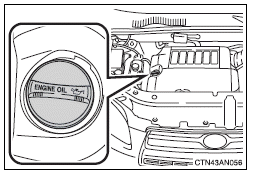 Toyota RAV4: Engine oil
Toyota RAV4: Engine oil
With the engine at operating temperature and turned off, check the oil level on the dipstick.
■ Checking the engine oil
1 Park the vehicle on level ground. After warming up the engine and turning it off, wait more than 5 minutes for the oil to drain back into the bottom of the engine.

Hold a rag under the end and pull the dipstick out.
3 Wipe the dipstick clean.
4 Reinsert the dipstick fully.
5 Holding a rag under the end, pull the dipstick out and check
the oil level.
6 Wipe the dipstick and reinsert it fully.
2.5 L 4-cylinder (2AR-FE) engine

1 Low
2 Full
3.5 L V6 (2GR-FE) engine

1 Low
2 Full
■ Adding engine oil

If the oil level is below or near the low level mark, add engine oil of the same type as already in the engine.
Make sure to check the oil type and prepare the items needed before adding oil.

1 Remove the oil filler cap by turning it counterclockwise.
2 Add engine oil slowly, checking the dipstick.
3 Install the oil filler cap by turning it clockwise.
■Engine oil consumption
A certain amount of engine oil will be consumed while driving. In the following situations, oil consumption may increase, and engine oil may need to be refilled in between oil maintenance intervals.
●When the engine is new, for example directly after purchasing the vehicle
or after replacing the engine
●If low quality oil or oil of an inappropriate viscosity is used
●When driving at high engine speeds or with a heavy load, when towing,
or when driving while accelerating or decelerating frequently
●When leaving the engine idling for a long time, or when driving frequently
through heavy traffic
CAUTION
■Used engine oil
●Used engine oil contains potentially harmful contaminants which may
cause skin disorders such as inflammation or skin cancer, so care should
be taken to avoid prolonged and repeated contact. To remove used engine
oil from your skin, wash thoroughly with soap and water.
●Dispose of used oil and filters only in a safe and acceptable manner. Do
not dispose of used oil and filters in household trash, in sewers or onto the
ground. Call your Toyota dealer, service station or auto parts store for
information concerning recycling or disposal.
●Do not leave used engine oil within the reach of children.
NOTICE
■To prevent serious engine damage
Check the oil level on a regular basis.
■When replacing the engine oil
●Be careful not to spill engine oil on the vehicle components.
●Avoid overfilling, as the engine could be damaged.
●Check the oil level on the dipstick every time you refill the vehicle.
●Be sure the engine oil filler cap is properly tightened.
 Engine compartment cover
Engine compartment cover
■ Removing the engine compartment cover
■ Installing the clips
NOTICE
■After installing an engine compartment cover
Make sure that the cover is securely installed in its orig ...
 Engine coolant
Engine coolant
The coolant level is satisfactory if it is between the “FULL” and “LOW”
lines on the reservoir when the engine is cold.
1 Reservoir cap
2 “FULL”
3 “LOW”
If the level is on or be ...
See also:
Towing load/specification
1: All towing above 1,000 lb (454 kg) requires the use of trailer brakes.
2: Sway control devices are not offered by NISSAN. See a professional
trailer/hitch outlet for a properly
designed sway ...
Changing the display
Changing the display
Press the TRIP button on the end of the left
column stalk repeatedly to display the trip data
in the following order:
- Date and odometer.
- Trip distance.
- Average speed ...
